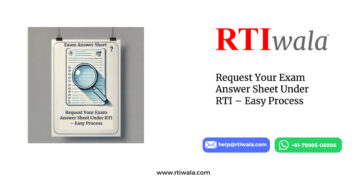E-commerce has transformed the way we shop, but it has also opened doors to various types of fraud, including fake products, deceptive sellers, and scam websites. The Right to Information (RTI) Act is a powerful tool that can help address these issues by exposing fraud and ensuring that e-commerce platforms operate transparently. This guide explains how you can use RTI to combat e-commerce fraud and how RTIwala can support you in the process.
Table of Contents
- Understanding E-Commerce Fraud
- How RTI Can Help in Addressing E-Commerce Fraud
- Step-by-Step Guide to Using RTI to Investigate E-Commerce Fraud
- How RTIwala Can Assist You
- Success Stories: RTIwala in Action
- FAQs
- Conclusion
Understanding E-Commerce Fraud
E-commerce fraud involves deceptive practices where sellers or websites mislead consumers. Common types of e-commerce fraud include:
- Fake Products: Sellers advertising products that do not match the description or are counterfeit.
- Deceptive Sellers: Sellers who provide false information about their credentials or services.
- Scam Websites: Websites designed to look legitimate but are created to steal personal and financial information.
These frauds can lead to financial losses and a lack of trust in online shopping platforms.
How RTI Can Help in Addressing E-Commerce Fraud
The RTI Act allows you to request information from public authorities, which can be crucial in addressing e-commerce fraud. Here’s how RTI can help:
- Verify Seller Credentials: Request information about the registration and licensing of e-commerce businesses.
- Check Compliance: Obtain details on whether the e-commerce platform complies with regulations and consumer protection laws.
- Access Complaint Records: Access records of complaints filed against the e-commerce seller or website.
Using RTI can reveal whether the seller or platform is operating legally and ethically, helping you take necessary actions against fraud.
Step-by-Step Guide to Using RTI to Investigate E-Commerce Fraud
Follow these steps to use RTI for investigating e-commerce fraud:
- Identify the Relevant Authority: Determine which government department or agency regulates e-commerce and consumer protection in your region. This might be the Ministry of Consumer Affairs or a local consumer protection body.
- Draft Your RTI Application: Write a clear RTI application specifying the information you need. Key queries might include:
- Verification of the e-commerce platform’s registration.
- Details of compliance with consumer protection regulations.
- Records of any complaints or actions taken against the seller or website.
- Submit the RTI Application: File your RTI application online through the RTI portal or physically at the concerned department. Make sure to include the necessary application fee.
- Follow Up: Track the status of your RTI application. If you do not receive a response within 30 days, you can file an appeal to seek the information.
How RTIwala Can Assist You
Navigating the RTI process can be complex, especially when dealing with e-commerce fraud. RTIwala provides expert assistance to make this process easier:
- RTI Drafting: RTIwala helps draft a clear and effective RTI application to ensure that you get the information you need.
- Application Filing: We assist with submitting your RTI application to the appropriate authorities, both online and offline.
- Follow-Up and Tracking: RTIwala tracks the status of your RTI application and ensures timely responses.
- Expert Guidance: Our team offers guidance on interpreting the information received and taking further action if necessary.
Success Stories: RTIwala in Action
RTIwala has successfully assisted clients in addressing e-commerce fraud. Here are a few examples:
- Case Study 1: RTIwala helped a customer verify the legitimacy of an online seller, leading to the exposure of a fraudulent scheme.
- Case Study 2: Our team assisted a group of consumers in accessing records of complaints against a scam website, resulting in regulatory action.
FAQs
Q1: What kind of information can I request about e-commerce fraud through RTI?
You can request details about the registration and licensing of e-commerce platforms, compliance with consumer protection laws, and records of complaints or actions taken.
Q2: How long does it take to get a response to an RTI application?
The public authority is required to respond within 30 days of receiving your RTI application.
Q3: What if I do not receive a response to my RTI application?
If you do not receive a response within the stipulated time, you can file an appeal with the relevant authority.
Q4: How can RTIwala assist me with e-commerce fraud cases?
RTIwala offers comprehensive support in drafting, filing, and tracking RTI applications, as well as expert guidance throughout the process.
Q5: Can RTI be used to resolve e-commerce fraud issues directly?
RTI helps uncover information related to fraud but addressing the issue may require additional legal or regulatory actions.
Conclusion
Using RTI to address e-commerce fraud is an effective way to ensure transparency and protect yourself from scams. By following the steps outlined in this guide and leveraging RTIwala expert assistance, you can effectively investigate and expose e-commerce fraud. If you need help with filing an RTI application or interpreting the information received, RTIwala is here to assist you every step of the way.
















































